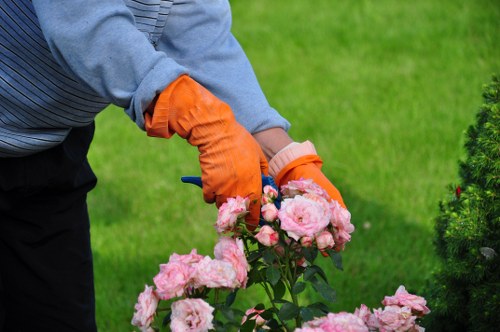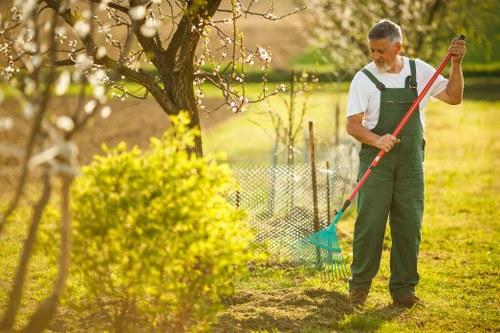Mastering Hedge Trimming in Hampstead: A Comprehensive Guide
Introduction to Hedge Trimming

Hedge trimming is an essential aspect of garden maintenance, enhancing both the aesthetic appeal and health of your hedges. In Hampstead, where gardens are cherished spaces, proper hedge trimming ensures that greenery remains vibrant and well-shaped throughout the year.
Whether you're a seasoned gardener or a novice, understanding the best practices for hedge trimming can make a significant difference in your garden's overall appearance. This guide delves into the techniques, tools, and tips necessary for effective hedge maintenance in Hampstead.
From identifying the right time to trim to selecting the best tools for the job, we've got you covered. Let's explore the art and science of hedge trimming to keep your Hampstead garden looking its best.
Why Hedge Trimming is Important

Health of the Hedge: Regular trimming promotes healthy growth by removing dead or diseased branches. This ensures that the hedge remains robust and resistant to pests and diseases.
Shape and Aesthetics: Trimming helps maintain a desired shape and size, contributing to the overall beauty of your garden. A well-maintained hedge can serve as a natural boundary, adding structure to your outdoor space.
Sunlight and Air Circulation: Properly trimmed hedges allow more sunlight to penetrate, promoting even growth. Improved air circulation reduces the risk of fungal infections and other issues related to poor ventilation.
When to Trim Your Hedges in Hampstead

The timing of hedge trimming is crucial for optimal growth and health. In Hampstead, the best times to trim hedges are:
- Early Spring: Before new growth begins, trimming in early spring encourages robust growth.
- Late Summer: A light trim in late summer maintains the shape without stimulating new growth that could be damaged by frost.
Avoid trimming during extreme weather conditions, such as heavy frost or intense heat, as this can stress the plants and lead to poor growth.
Understanding the seasonal patterns of your specific hedge type will help you determine the most appropriate times for trimming.
Essential Tools for Hedge Trimming

Having the right tools is key to efficient and effective hedge trimming. Essential tools include:
- Hedge Shears: Ideal for precise trimming and shaping.
- Pruning Saws: Useful for cutting thicker branches that shears can't handle.
- Loppers: Provide the leverage needed for larger branches.
- Protective Gear: Gloves, safety glasses, and sturdy footwear protect you during the trimming process.
Investing in high-quality tools ensures clean cuts, which are vital for the health of your hedges. Regular maintenance of these tools, such as sharpening blades, extends their lifespan and improves performance.
Consider ergonomic designs to reduce fatigue during prolonged use, especially if you have extensive hedges.
Step-by-Step Guide to Trimming Hedges

1. Assess Your Hedge: Determine the current shape and health of your hedge. Identify any dead or diseased branches that need immediate attention.
2. Plan the Shape: Decide on the desired shape, whether it's formal and straight or natural and flowing. Visualizing the end result helps in making precise cuts.
- Formal Shape: Usually involves straight lines and uniform height.
- Natural Shape: Mimics the hedge's natural growth, focusing on overall health and appearance rather than strict lines.
3. Start Trimming: Begin from the bottom, working your way up. This method ensures that lower branches are properly trimmed without being overshadowed by the upper cuts.
4. Make Clean Cuts: Use sharp tools to make clean, angled cuts. Avoid tearing or crushing the branches, which can lead to disease.
5. Step Back and Assess: Periodically step back to evaluate the hedge's shape and make adjustments as needed. This ensures that both sides are even and the overall form is balanced.
Maintaining the Right Height
Consistency is key when maintaining hedge height. Regular trimming prevents overgrowth and makes future trimming easier. Establishing a routine schedule, such as trimming twice a year, helps maintain the desired height and shape.
Top and Sides: Focus on trimming both the top and sides equally to achieve a uniform appearance.
Use guides or string lines if necessary to maintain straight edges, especially for formal hedges.
Dealing with Overgrown Hedges
Managing overgrown hedges requires patience and the right approach:
- Initial Heavy Trimming: Start with light cuts to avoid shocking the plant.
- Gradual Shaping: Over several trimming sessions, gradually shape the hedge to its desired form.
- Regular Maintenance: Once the hedge is back in shape, adhere to a regular trimming schedule to prevent future overgrowth.
Avoid removing more than one-third of the hedge in a single trimming session to prevent stress and promote healthy regrowth.
Common Mistakes to Avoid

Even with the best intentions, certain mistakes can hinder the effectiveness of hedge trimming:
- Trimming at the Wrong Time: Cutting hedges during poor weather conditions can expose them to diseases and stress.
- Using Dull Tools: Dull blades tear branches rather than cutting them cleanly, which can damage the plant.
- Over-Trimming: Removing too much foliage at once can weaken the hedge and stunt its growth.
- Ignoring Plant-Specific Needs: Different hedge species have varying trimming requirements. Not adhering to these can result in poor health and appearance.
By being aware of these common pitfalls, you can ensure that your hedge trimming efforts are both effective and beneficial to your garden.
Learn more about specific hedging techniques for different plant types to tailor your approach accordingly.
Choosing the Right Plants for Your Hedge

Selecting the appropriate plants for your hedge is foundational to successful trimming. Consider the following factors:
- Climate Adaptability: Ensure the plant species are well-suited to Hampstead's climate.
- Growth Rate: Fast-growing plants require more frequent trimming, while slower-growing varieties may need less maintenance.
- Desired Aesthetic: Choose plants that align with the desired look, whether formal or natural.
- Maintenance Needs: Consider the amount of time and effort you're willing to invest in upkeep.
Popular hedge plants in Hampstead include:
- Boxwood: Excellent for formal hedges with dense foliage.
- Privet: Fast-growing and versatile, suitable for various hedge styles.
- Yew: Long-lived and tolerant of heavy trimming, ideal for structured hedges.
- Laurel: Offers glossy leaves and a robust structure.
Consider Native Species
Incorporating native plants can enhance biodiversity and reduce maintenance, as they are naturally adapted to the local environment.
Researching and selecting the right plants will contribute to a healthy, sustainable hedge that thrives with proper care.
Professional Hedge Trimming Services in Hampstead

While DIY trimming is feasible for small hedges, larger or intricate ones may benefit from professional services. Professionals bring expertise, the right tools, and the ability to handle complex trimming tasks efficiently.
Benefits of Hiring Professionals:
- Expertise: Professionals understand the specific needs of different hedge species.
- Time-Saving: Outsourcing saves you time and effort.
- Safety: Professionals are trained to handle equipment safely, reducing the risk of accidents.
- Quality Results: Achieve a polished and well-maintained hedge without the hassle.
Choosing the Right Service
When selecting a hedge trimming service in Hampstead, consider the following:
- Reputation: Look for reviews or ask for recommendations to ensure reliability.
- Experience: Choose a service with experience handling various hedge types.
- Pricing: Compare quotes to find a service that offers good value without compromising quality.
- Insurance: Ensure the service is insured to cover any potential damages.
Investing in a reputable service ensures your hedges are in capable hands, fostering their health and appearance for years to come.
Eco-Friendly Trimming Practices

Adopting eco-friendly practices in hedge trimming contributes to a sustainable garden. Here are some tips:
- Use Manual Tools: Whenever possible, use manual shears instead of gas-powered tools to reduce emissions.
- Recycle Clippings: Compost hedge clippings to create nutrient-rich soil for your garden.
- Choose Sustainable Materials: Opt for tools made from sustainable materials and consider their lifespan.
- Minimize Waste: Trim carefully to reduce excessive waste and ensure all clippings are utilized effectively.
Implementing these practices not only benefits the environment but also promotes a healthier, more resilient garden ecosystem.
Consider integrating native plants and sustainable methods to further enhance your garden's ecological footprint.
Seasonal Hedge Maintenance Tips
Each season brings its own set of requirements for hedge maintenance. Here's how to adjust your trimming practices throughout the year in Hampstead:
- Spring: Focus on encouraging new growth by lightly trimming and shaping.
- Summer: Maintain the shape and remove any overgrown branches to ensure adequate sunlight.
- Autumn: Prepare hedges for winter by cleaning up fallen debris and making any necessary cuts.
- Winter: Minimal trimming is recommended; use this time to plan for the upcoming trimming season.
Protecting Hedges in Winter
Winter protection involves safeguarding hedges from frost and heavy snow. Applying a layer of mulch can help insulate the roots, while proper trimming ensures that the hedge is not weighed down by excessive growth.
Regular inspections during winter ensure that any issues are addressed promptly, maintaining hedge health year-round.
Common Hedge Problems and Solutions

Hedges can face various challenges that impact their health and appearance. Here are some common problems and their solutions:
- Pest Infestations: Use organic or chemical treatments as needed and maintain good garden hygiene to prevent pests.
- Disease: Remove infected branches promptly and ensure proper trimming techniques to avoid spreading disease.
- Overgrowth: Regular trimming and monitoring prevent hedges from becoming overgrown and unmanageable.
- Sunlight Restrictions: Thinning out excessively dense areas allows more light to reach inner parts of the hedge.
Addressing these issues promptly ensures that your hedges remain healthy and visually appealing throughout the year.
Consulting with professionals can provide targeted solutions for severe or persistent problems.
Innovative Trimming Techniques
Embracing innovative trimming techniques can enhance the health and appearance of your hedges. Some modern approaches include:
- Topiary: Sculpting hedges into artistic shapes and figures.
- Selective Pruning: Removing specific branches to promote airflow and sunlight penetration.
- Line Trimming: Using string lines or guides to achieve precision in trimming.
- Natural Shaping: Allowing hedges to grow in a more natural form, focusing on overall health rather than strict shapes.
Experimenting with these techniques can add unique character to your garden while maintaining healthy hedges.
Stay informed about the latest trends and practices in hedge trimming to continually improve your garden's aesthetics.
Conclusion: Keeping Your Hampstead Garden Pristine

Effective hedge trimming is a blend of art and science, requiring knowledge, precision, and regular maintenance. In Hampstead, where gardens are treasured, mastering hedge trimming ensures that your outdoor space remains beautiful and vibrant year-round.
By following best practices, investing in the right tools, and considering professional assistance when needed, you can maintain healthy and stunning hedges that enhance your garden's appeal.
Don't wait—contact us today to elevate your garden with expert hedge trimming services tailored to your needs. Book your service now and enjoy the lush, well-maintained hedges you've always desired.